A Phenomenological Study of Lab-Scale Tidal Turbine Loading under Combined Irregular Wave and Shear Flow Conditions
Abstract
1. Introduction
2. Methodology and Experimental Setup
2.1. Turbine Model
Turbine Measurement Instrumentation
3. Flow Characterisation
4. Turbine Performance
4.1. Mean Rotor Performance
4.2. Analysis of Cross-Covariance
4.3. Variation of Blade Root Bending Moments
5. Spectral Analysis
5.1. Power Spectral Density
5.2. Spectral Cohesion Analysis
6. Conclusions
Author Contributions
Funding
Institutional Review Board Statement
Informed Consent Statement
Data Availability Statement
Conflicts of Interest
Appendix A. Time Lag Calculation—Combined Wave and Current
References
- SIMEC Atlantis Energy. Tidal Stream Projects: MeyGen. Available online: https://simecatlantis.com/projects/meygen/ (accessed on 17 May 2021).
- Meygen Ltd. Lessons Learnt from MeyGen Phase 1a: Design Phase. Technical Report; 2017. Available online: https://tethys.pnnl.gov/sites/default/files/publications/MeyGen-2017-Part1.pdf (accessed on 17 May 2021).
- Nova Innovation. Nova Wins €5 Million European Tidal Energy Project to Slash Cost of Tidal Energy. Available online: https://www.novainnovation.com/news/news_/i/nova-wins-5million-euro-european-tidal-energy-project-to-slash-the-cost-of-tidal-energy/ (accessed on 17 May 2021).
- Blackmore, T.; Myers, L.E.; Bahaj, A.S. Effects of turbulence on tidal turbines: Implications to performance, blade loads, and condition monitoring. Int. J. Mar. Energy 2016, 14, 1–26. [Google Scholar] [CrossRef]
- Maganga, F.; Germain, G.; King, J.; Pinon, G.; Rivoalen, E. Experimental characterisation of flow effects on marine current turbine behaviour and on its wake properties. IET Renew. Power Gener. 2010, 4, 498–509. [Google Scholar] [CrossRef]
- Mycek, P.; Gaurier, B.; Germain, G.; Pinon, G.; Rivoalen, E. Experimental study of the turbulence intensity effects on marine current turbines behaviour. Part I: One single turbine. Renew. Energy 2014, 66, 729–746. [Google Scholar] [CrossRef]
- Gaurier, B.; Davies, P.; Deuff, A.; Germain, G. Flume tank characterization of marine current turbine blade behaviour under current and wave loading. Renew. Energy 2013, 59, 1–12. [Google Scholar] [CrossRef]
- Martinez, R.; Ordonez-Sanchez, S.; Allmark, M.; Lloyd, C.; O’Doherty, T.; Germain, G.; Gaurier, B.; Johnstone, C. Analysis of the effects of control strategies and wave climates on the loading and performance of a laboratory scale horizontal axis tidal turbine. Ocean Eng. 2020, 212, 107713. [Google Scholar] [CrossRef]
- Ordonez-Sanchez, S.; Allmark, M.; Porter, K.E.; Ellis, R.; Lloyd, C.; Santic, I.; O’Doherty, T.; Johnstone, C. Analysis of a Horizontal-Axis Tidal Turbine Performance in the Presence of Regular and Irregular Waves Using Two Control Strategies. Energies 2019, 12, 367. [Google Scholar] [CrossRef]
- Draycott, S.; Nambiar, A.; Sellar, B.G.; Davey, T.A.D.; Venugopal, V. Assessing extreme loads on a tidal turbine using focused wave groups in energetic currents. Renew. Energy 2019, 135, 1013–1024. [Google Scholar] [CrossRef]
- Draycott, S.; Payne, G.S.; Steynor, J.; Nambiar, A.; Sellar, B.G.; Venugopal, V. An experimental investigation into non-linear wave loading on horizontal axis tidal turbines. J. Fluids Struct. 2019, 84, 199–217. [Google Scholar] [CrossRef]
- Draycott, S.; Steynor, J.; Nambiar, A.; Sellar, B.; Venugopal, V. Experimental assessment of tidal turbine loading from irregular waves over a tidal cycle. J. Ocean. Eng. Mar. Energy 2019, 5, 173–187. [Google Scholar] [CrossRef]
- Lewis, M.; Neill, S.P.; Robins, P.; Hashemi, M.R.; Ward, S. Characteristics of the velocity profile at tidal-stream energy sites. Renew. Energy 2017, 114, 258–272. [Google Scholar] [CrossRef]
- Allmark, M.; Ellis, R.; Ebdon, T.; Lloyd, C.; Ordonez-Sanchez, S.; Martinez, R.; Mason-Jones, A.; Johnstone, C.; O’Doherty, T. A detailed study of tidal turbine power production and dynamic loading under grid generated turbulence and turbine wake operation. Renew. Energy 2020, 169, 1422–1439. [Google Scholar] [CrossRef]
- Mycek, P.; Gaurier, B.; Germain, G.; Pinon, G.; Rivoalen, E. Experimental study of the turbulence intensity effects on marine current turbines behaviour. Part II: Two interacting turbines. Renew. Energy 2014, 68, 876–892. [Google Scholar] [CrossRef]
- Ahmed, U.; Apsley, D.D.; Afgan, I.; Stallard, T.; Stansby, P.K. Fluctuating loads on a tidal turbine due to velocity shear and turbulence: Comparison of CFD with field data. Renew. Energy 2017, 112, 235–246. [Google Scholar] [CrossRef]
- Ebdon, T.; Allmark, M.; O’Doherty, D.; Mason-Jones, A.; O’Doherty, T.; Germain, G.; Gaurier, B. The impact of turbulence and turbine operating condition on the wakes of tidal turbines. Renew. Energy 2021, 165. [Google Scholar] [CrossRef]
- Gaurier, B.; Ikhennicheu, M.; Germain, G.; Druault, P. Experimental study of bathymetry generated turbulence on tidal turbine behaviour. Renew. Energy 2020, 156, 1158–1170. [Google Scholar] [CrossRef]
- Deskos, G.; Payne, G.S.; Gaurier, B.; Graham, M. On the spectral behaviour of the turbulence-driven power fluctuations of horizontal-axis turbines. J. Fluid Mech. 2020, 904, 13–14. [Google Scholar] [CrossRef]
- Blackmore, T.; Blunden, L.S.; Shah, K.; Myers, L.E.; Bahaj, A.S. The impact of a real tidal flow on the fatigue loads acting on a tidal turbine. In Proceedings of the 3rd Asian Wave and Tidal Energy Conference, Singapore, 24–28 October 2016. [Google Scholar] [CrossRef]
- Tobin, N.; Zhu, H.; Chamorro, L.P. Spectral behaviour of the turbulence-driven power fluctuations of wind turbines. J. Turbul. 2015, 16, 832–846. [Google Scholar] [CrossRef]
- Milne, I. An Experimental Investigation of Turbulence and Unsteady Loading on Tidal Turbines. Ph.D. Thesis, The University of Auckland, Auckland, New Zealand, 2014. [Google Scholar]
- Milne, I.A.; Day, A.H.; Sharma, R.N.; Flay, R.G. The characterisation of the hydrodynamic loads on tidal turbines due to turbulence. Renew. Sustain. Energy Rev. 2016, 56, 851–864. [Google Scholar] [CrossRef]
- Sentchev, A.; Thiébaut, M.; Schmitt, F.G. Impact of turbulence on power production by a free-stream tidal turbine in real sea conditions. Renew. Energy 2020, 147, 1932–1940. [Google Scholar] [CrossRef]
- Chamorro, L.P.; Hill, C.; Morton, S.; Ellis, C.; Arndt, R.E.; Sotiropoulos, F. On the interaction between a turbulent open channel flow and an axial-flow turbine. J. Fluid Mech. 2013, 716, 658–670. [Google Scholar] [CrossRef]
- Medina, O.D.; Schmitt, F.G.; Calif, R.; Germain, G.; Gaurier, B. Turbulence analysis and multiscale correlations between synchronized flow velocity and marine turbine power production. Renew. Energy 2017, 112, 314–327. [Google Scholar] [CrossRef]
- Noble, D.R.; Draycott, S.; Nambiar, A.; Sellar, B.G.; Steynor, J.; Kiprakis, A. Experimental Assessment of Flow, Performance, and Loads for Tidal Turbines in a Closely-Spaced Array. Energies 2020, 13, 1977. [Google Scholar] [CrossRef]
- Gaurier, B.; Carlier, C.; Germain, G.; Pinon, G.; Rivoalen, E. Three tidal turbines in interaction: An experimental study of turbulence intensity effects on wakes and turbine performance. Renew. Energy 2020, 148, 1150–1164. [Google Scholar] [CrossRef]
- Lloyd, C.; Allmark, M.; Ordonez-Sanchez, S.; Martinez, R.; Johnstone, C.; Germain, G.; Gaurier, B.; Mason-Jones, A.; O’Doherty, T. Validation of the dynamic load characteristics on a Tidal Stream Turbine when subjected to wave and current interaction. Ocean. Eng. 2021, 222. [Google Scholar] [CrossRef]
- Porter, K.; Ordonez-Sanchez, S.; Murray, R.; Allmark, M.; Johnstone, C.; O’Doherty, T.; Mason-Jones, A.; Doman, D.; Pegg, M. Flume testing of passively adaptive composite tidal turbine blades under combined wave and current loading. J. Fluids Struct. 2020, 93. [Google Scholar] [CrossRef]
- Allmark, M. Performance Assessment of a Horizontal Axis Tidal Turbine in a High Velocity Shear Environment. Ph.D. Thesis, Cardiff University, Cardiff, UK, 2010. [Google Scholar]
- Ke, S.; Wen-Quan, W.; Yan, Y. The hydrodynamic performance of a tidal-stream turbine in shear flow. Ocean. Eng. 2020, 199, 107035. [Google Scholar] [CrossRef]
- Martinez, R.; Payne, G.S.; Bruce, T. The effects of oblique waves and current on the loadings and performance of tidal turbines. Ocean. Eng. 2017, 164, 55–64. [Google Scholar] [CrossRef]
- Gaurier, B.; Germain, G.; Facq, J.V.; Thomas, B. Wave and Current Flume Tank of IFREMER at Boulogne-sur-mer. Description of the Facility and Its Equipment; Technical Report; Institut Français de Recherche pour l’Exploitation de la Mer (IFREMER): Boulogne-sur-Mer, France, 2018. [Google Scholar] [CrossRef]
- Allmark, M.; Ellis, R.; Lloyd, C.; Ordonez-Sanchez, S.; Johannesen, K.; Byrne, C.; Johnstone, C.; O’Doherty, T.; Mason-Jones, A. The development, design and characterisation of a scale model Horizontal Axis Tidal Turbine for dynamic load quantification. Renew. Energy 2020, 156, 913–930. [Google Scholar] [CrossRef]
- Ellis, R.; Allmark, M.; Doherty, T.O.; Mason-jones, A.; Ordonez-sanchez, S.; Johannesen, K.; Johnstone, C. Design Process for a Scale Horizontal Axis Tidal Turbine Blade. In Proceedings of the 4th Asian Wave and Tidal Energy Conference, Taipei, Taiwan, 9–13 September 2018; pp. 1–8. [Google Scholar]
- Perez, L.; Cossu, R.; Couzi, C.; Penesis, I. Wave-turbulence decomposition methods applied to tidal energy site assessment. Energies 2020, 13, 1245. [Google Scholar] [CrossRef]
- Taylor, G.I. Statistical Theory of Turbulence. Proc. R. Soc. Lond. Ser. A Math. Phys. Sci. 1935, 151, 421–444. [Google Scholar] [CrossRef]
- Allmark, M.; Grosvenor, R.; Prickett, P. An approach to the characterisation of the performance of a tidal stream turbine. Renew. Energy 2017, 111. [Google Scholar] [CrossRef]
- Allmark, M. Condition Monitoring and Fault Diagnosis of Tidal Stream Turbines Subjected to Rotor Imbalance Faults. Ph.D. Thesis, Cardiff University, Cardiff, UK, 2016. [Google Scholar]
- Martinez, R.; Gaurier, B.; Ordonez-Sanchez, S.; Facq, J.V.; Germain, G.; Johnstone, C.; Santic, I.; Salvatore, F.; Davey, T.; Old, C.; et al. Tidal Energy Round Robin Tests: A Comparison of Flow Measurements and Turbine Loading. J. Mar. Sci. Eng. 2021, 9, 425. [Google Scholar] [CrossRef]
- Dean, R.G.; Dalrymple, R.A. Water Wave Mechanics for Engineers and Scientists; World Scientific: Singapore, 1991. [Google Scholar] [CrossRef]
- Phillips, O. The Dynamics of the Upper Ocean; Cambridge Monographs on Mechanics; Cambridge University Press: Cambridge, UK, 1977. [Google Scholar]
- Peregrine, D.H. Interaction of water waves and currents. Adv. Appl. Mech. 1976, 16, 9–117. [Google Scholar] [CrossRef]

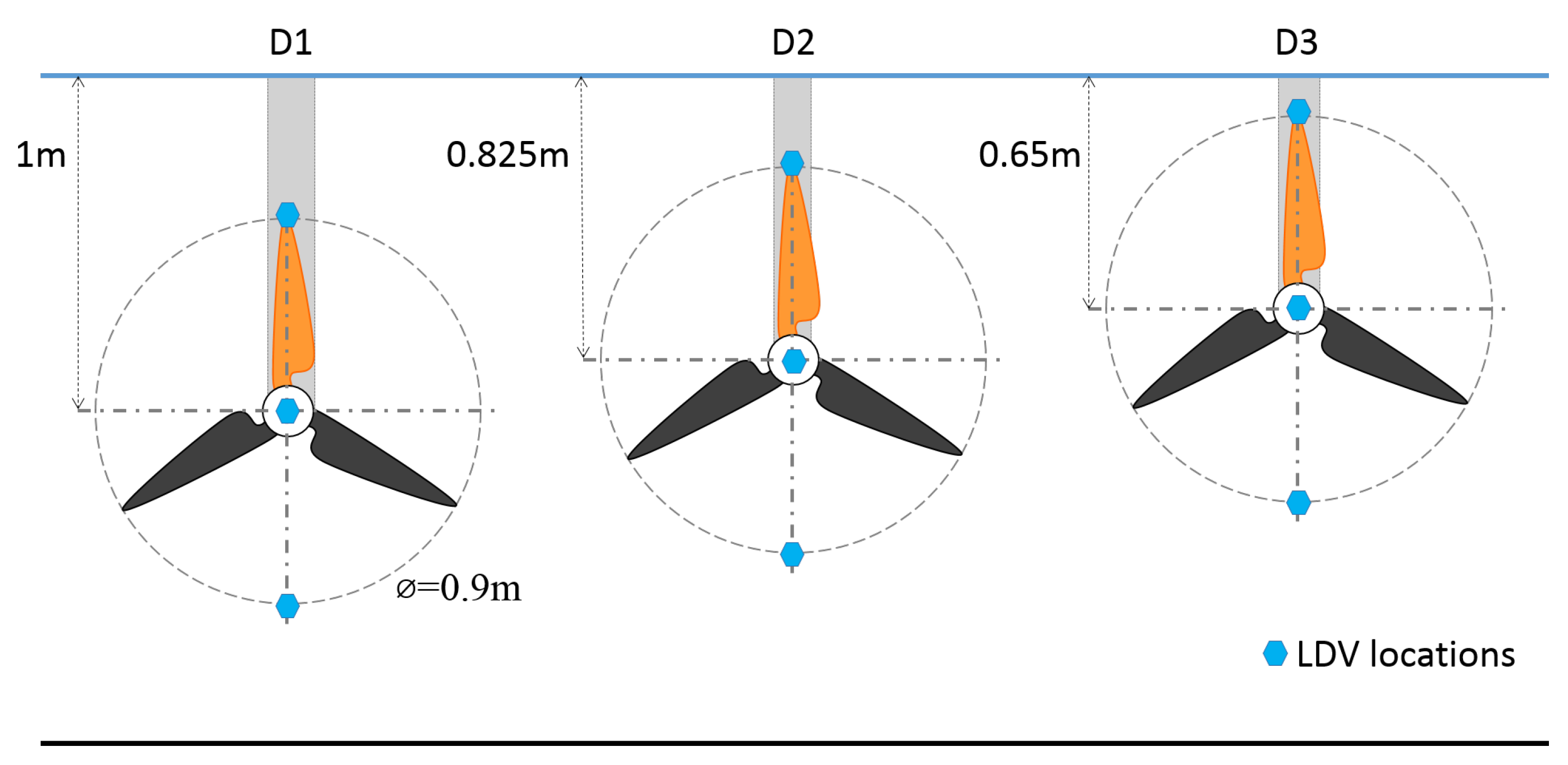
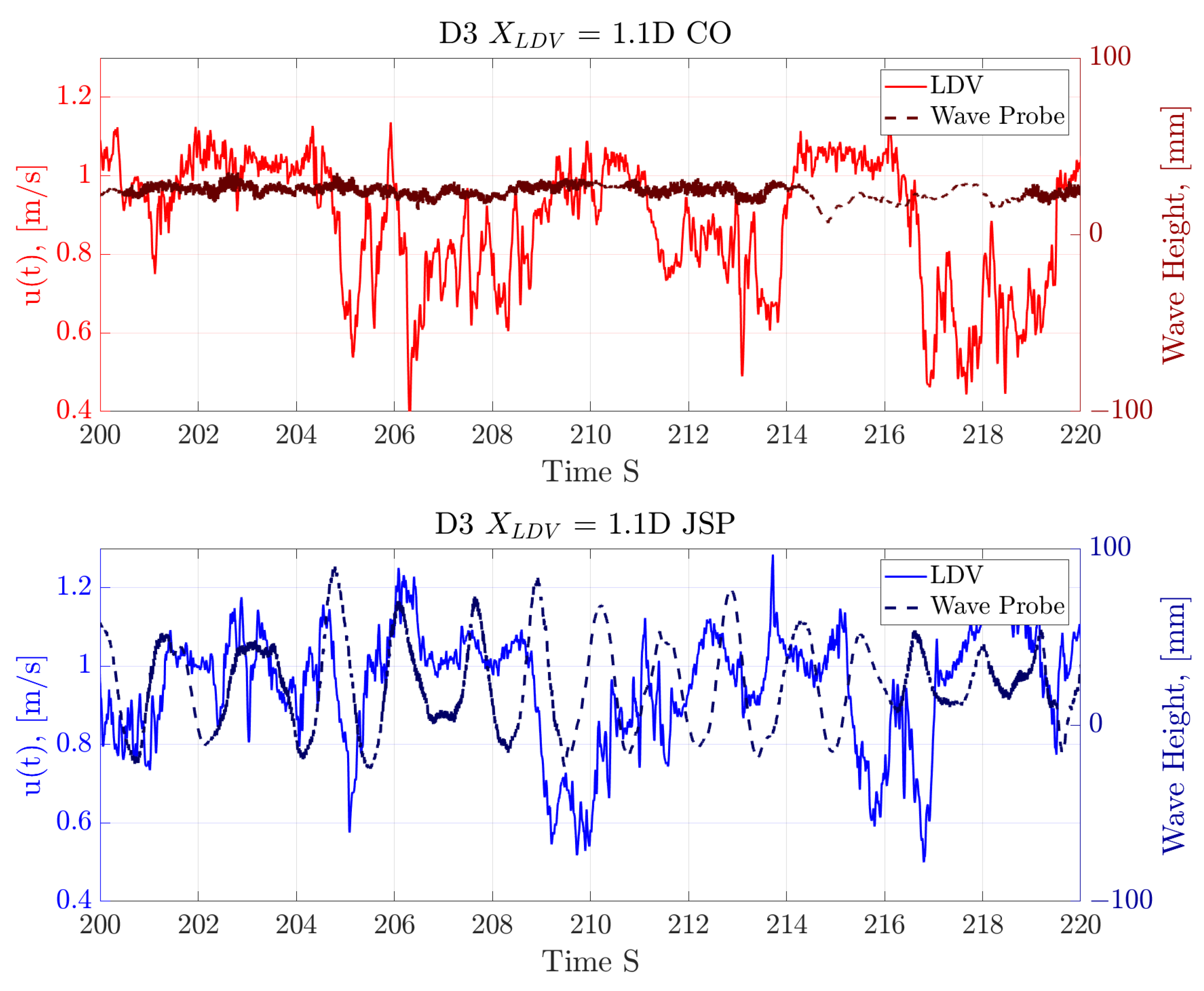
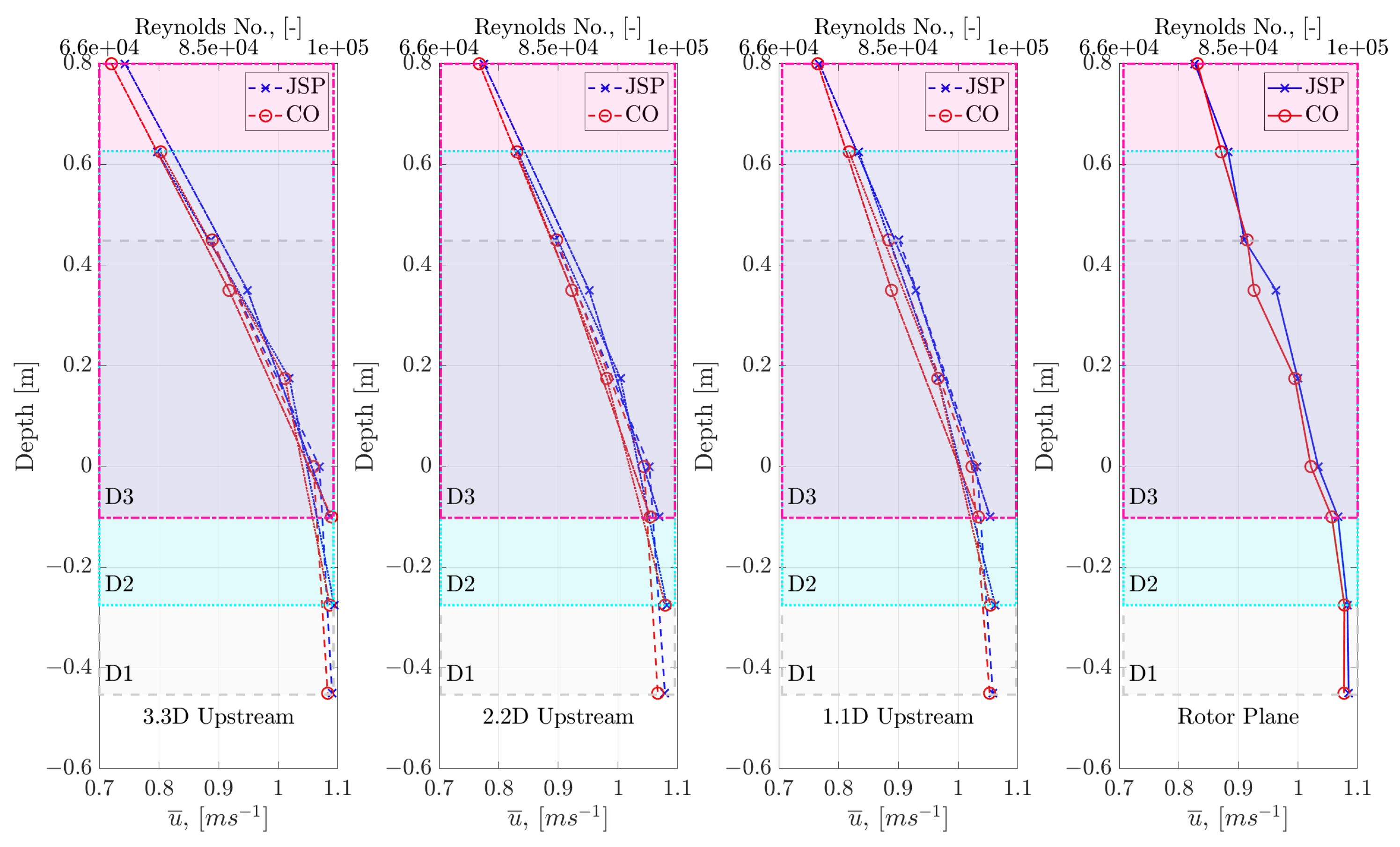
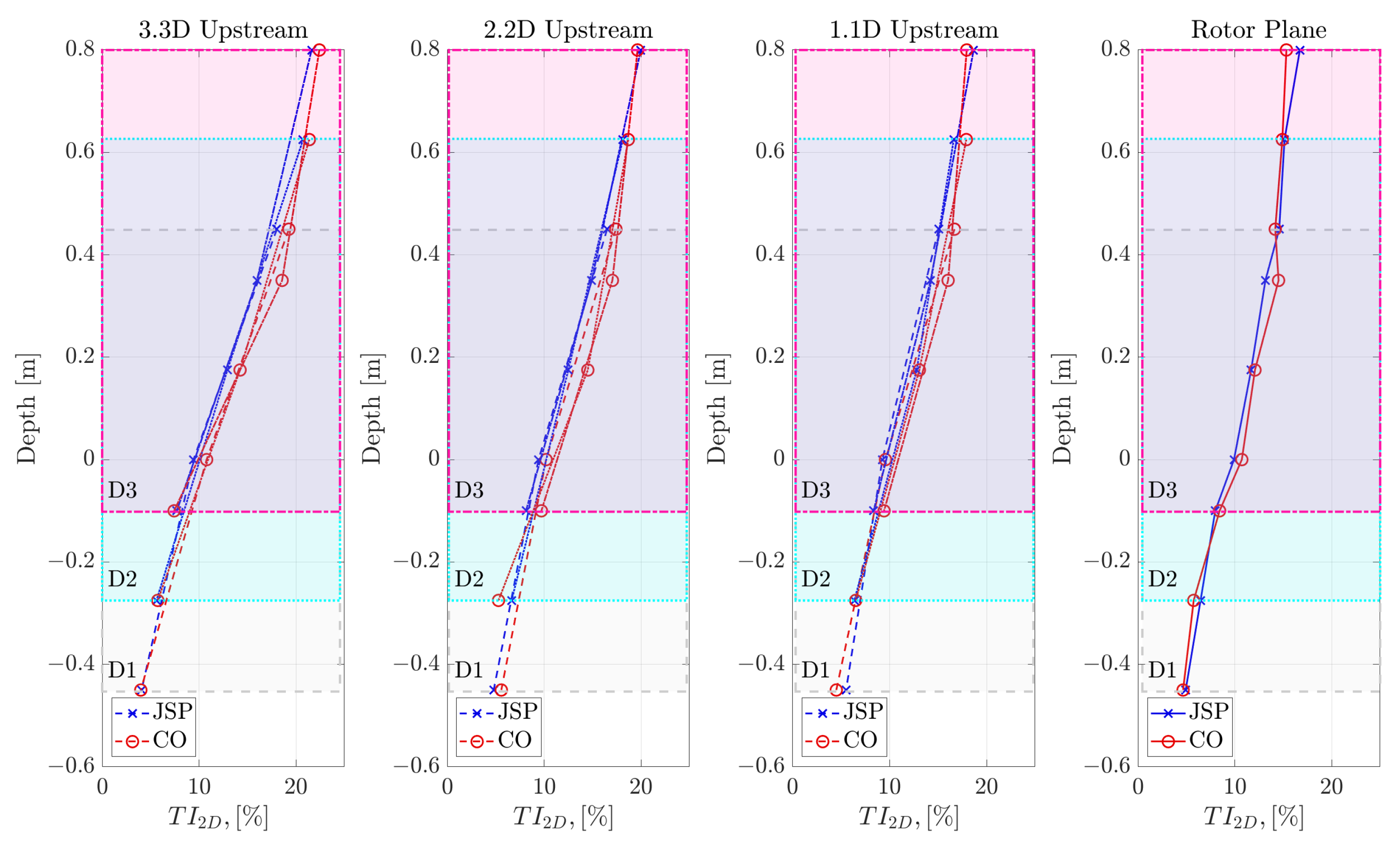
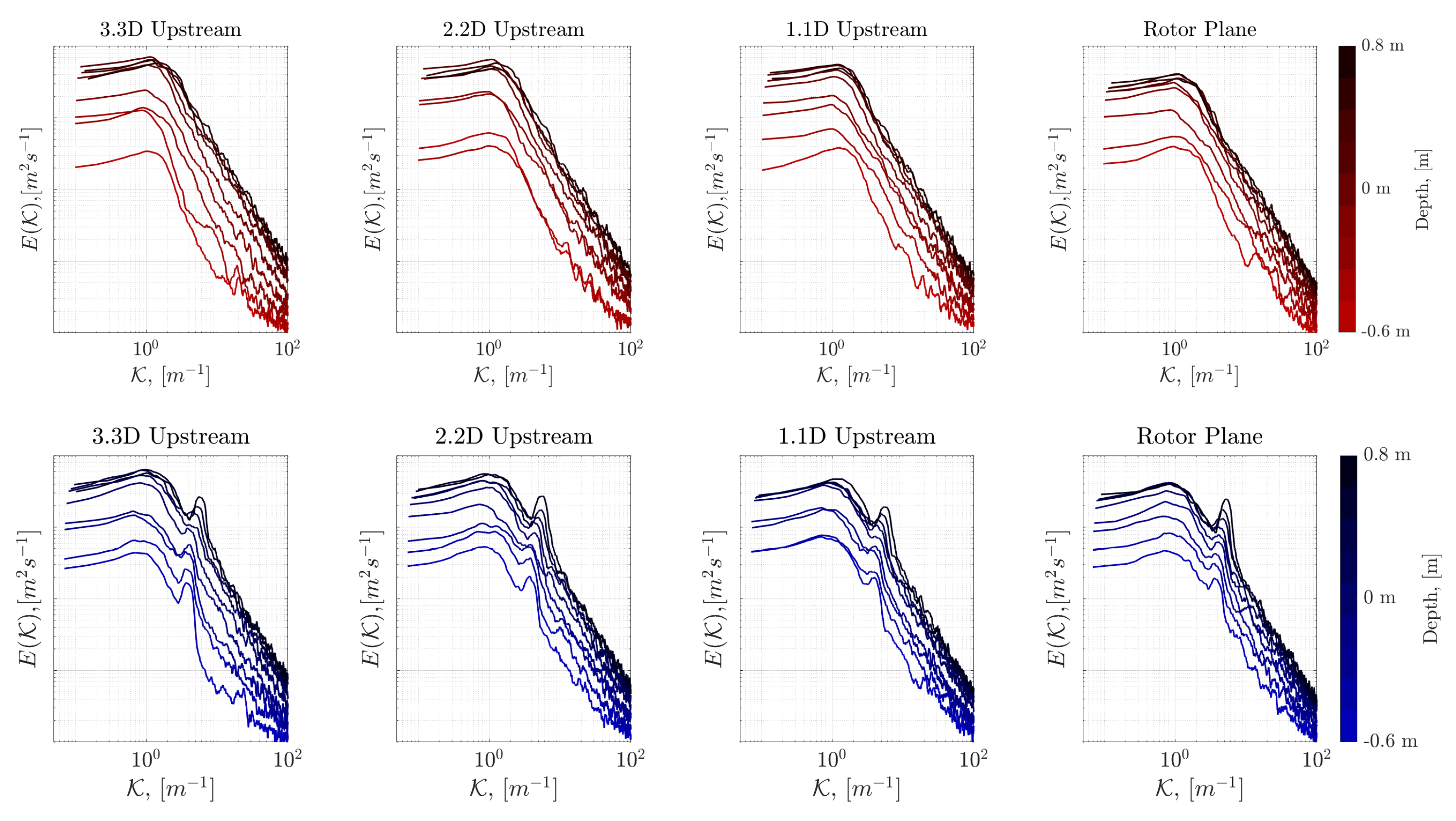
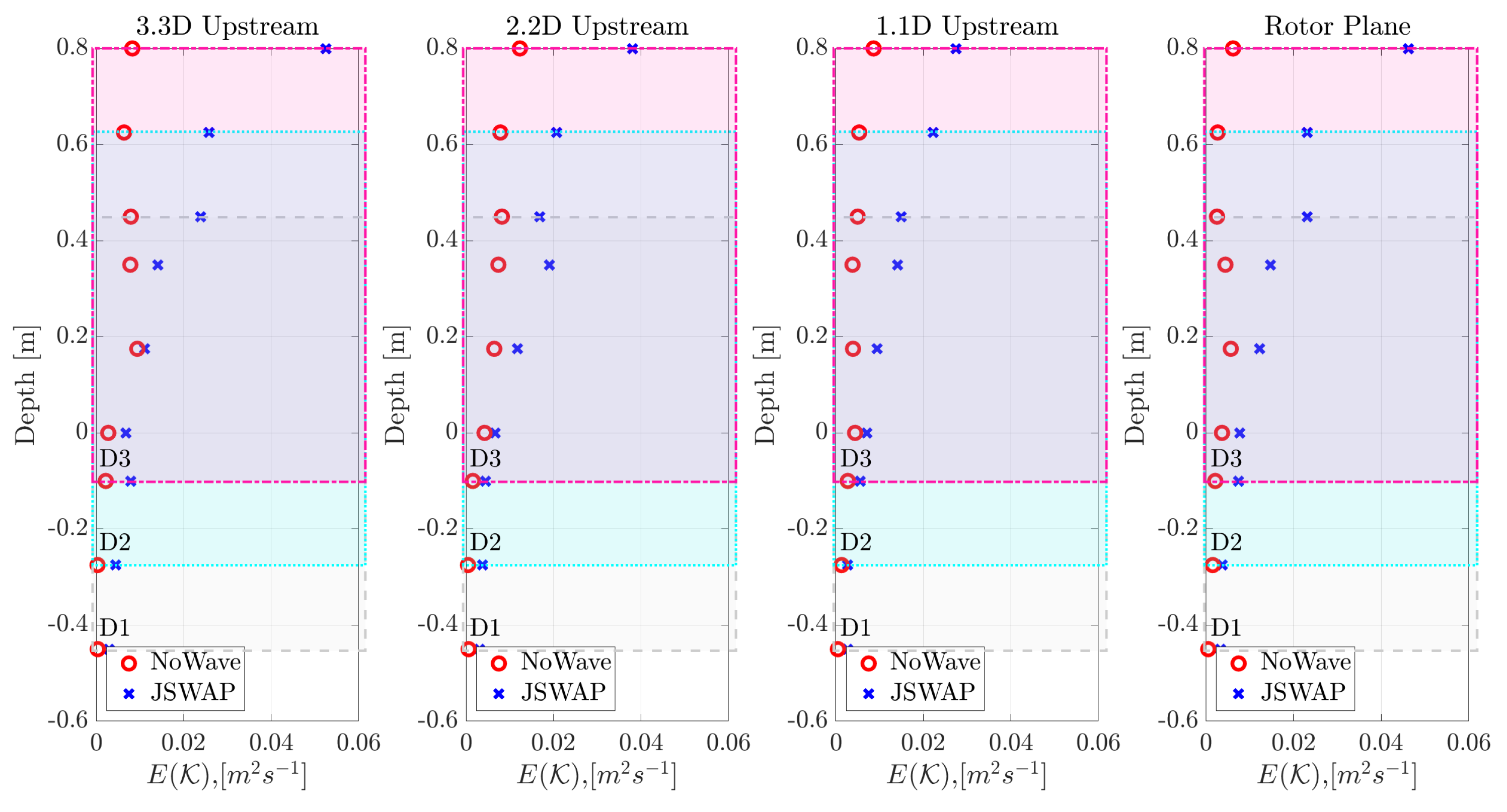
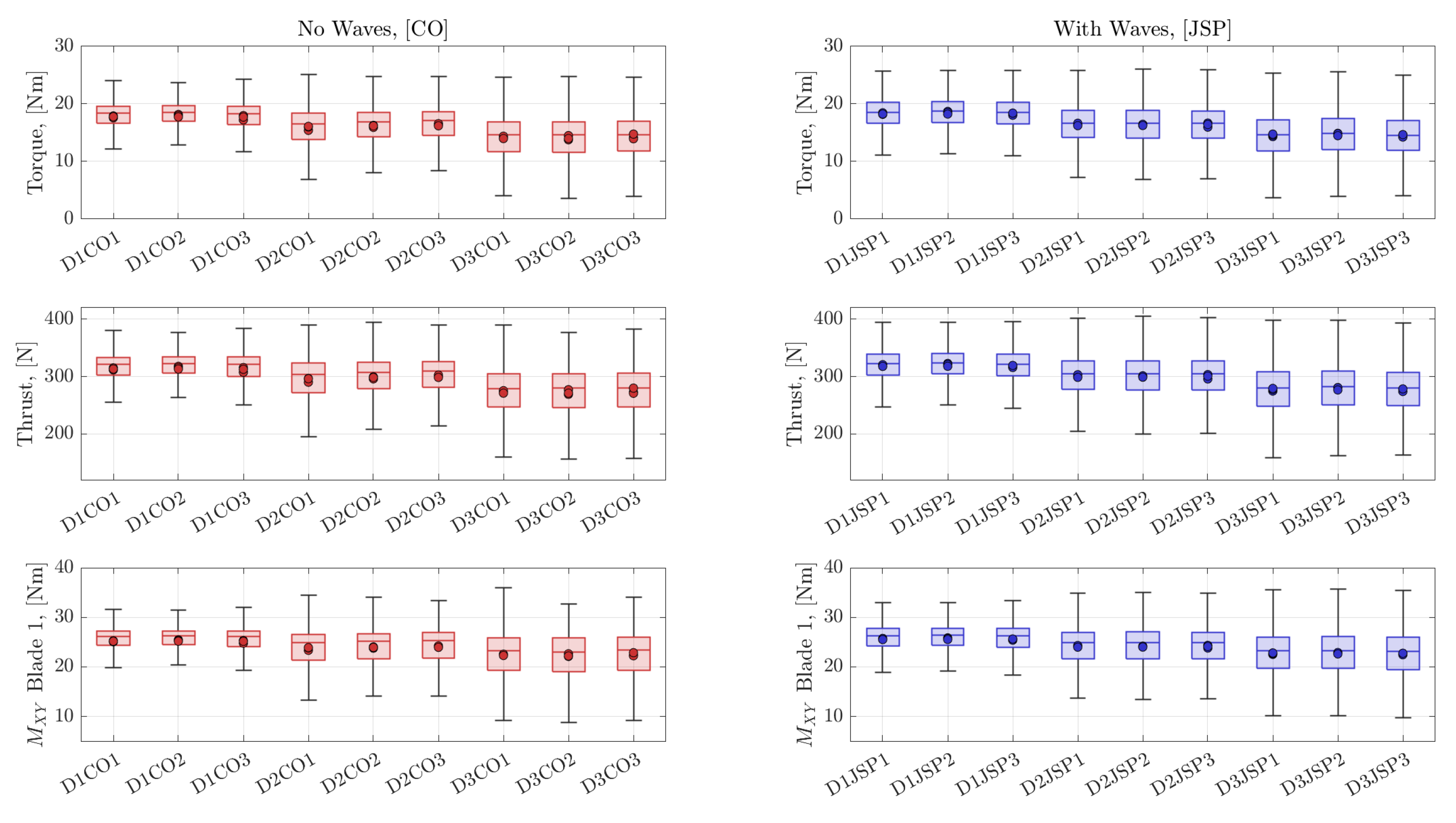
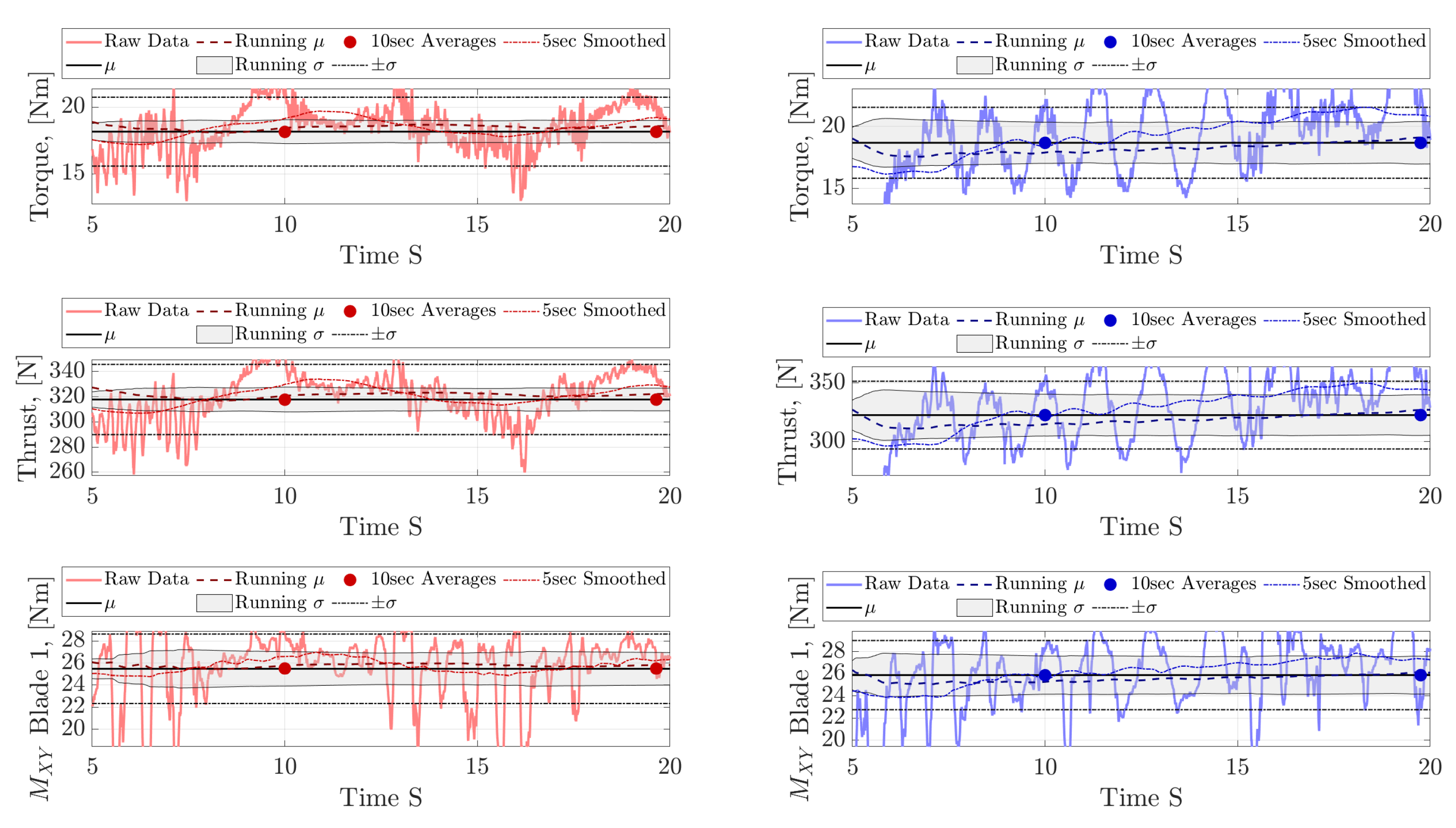
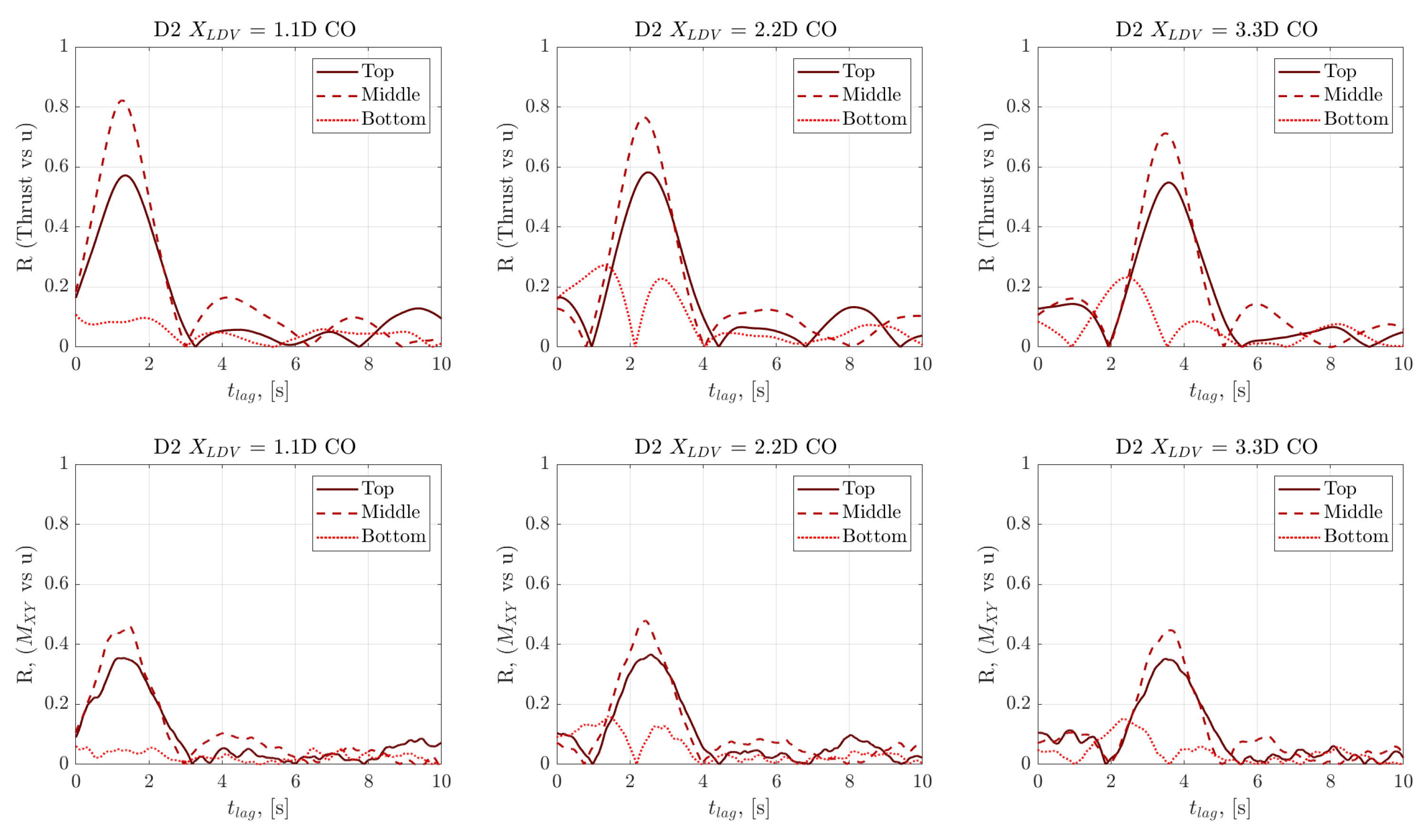
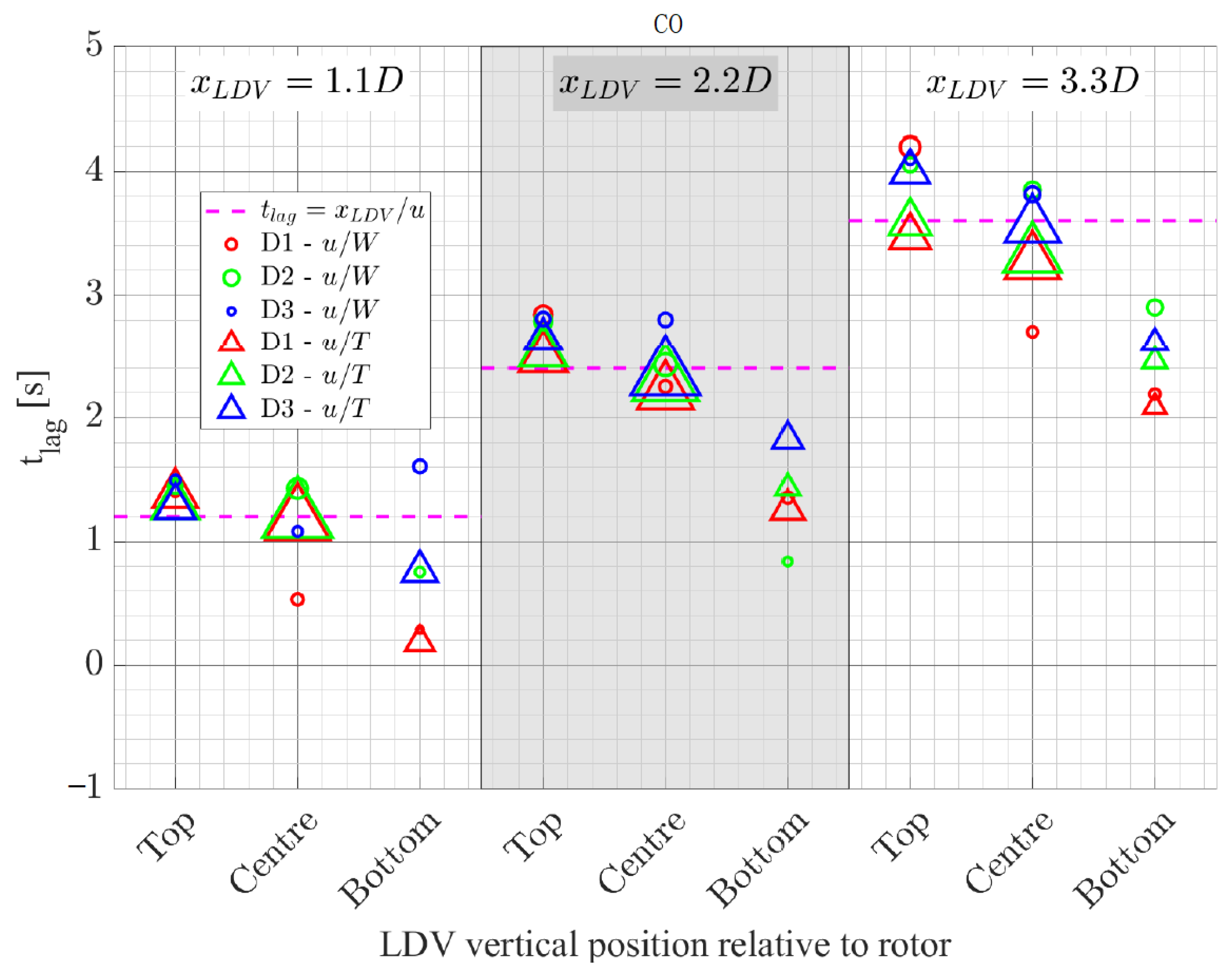
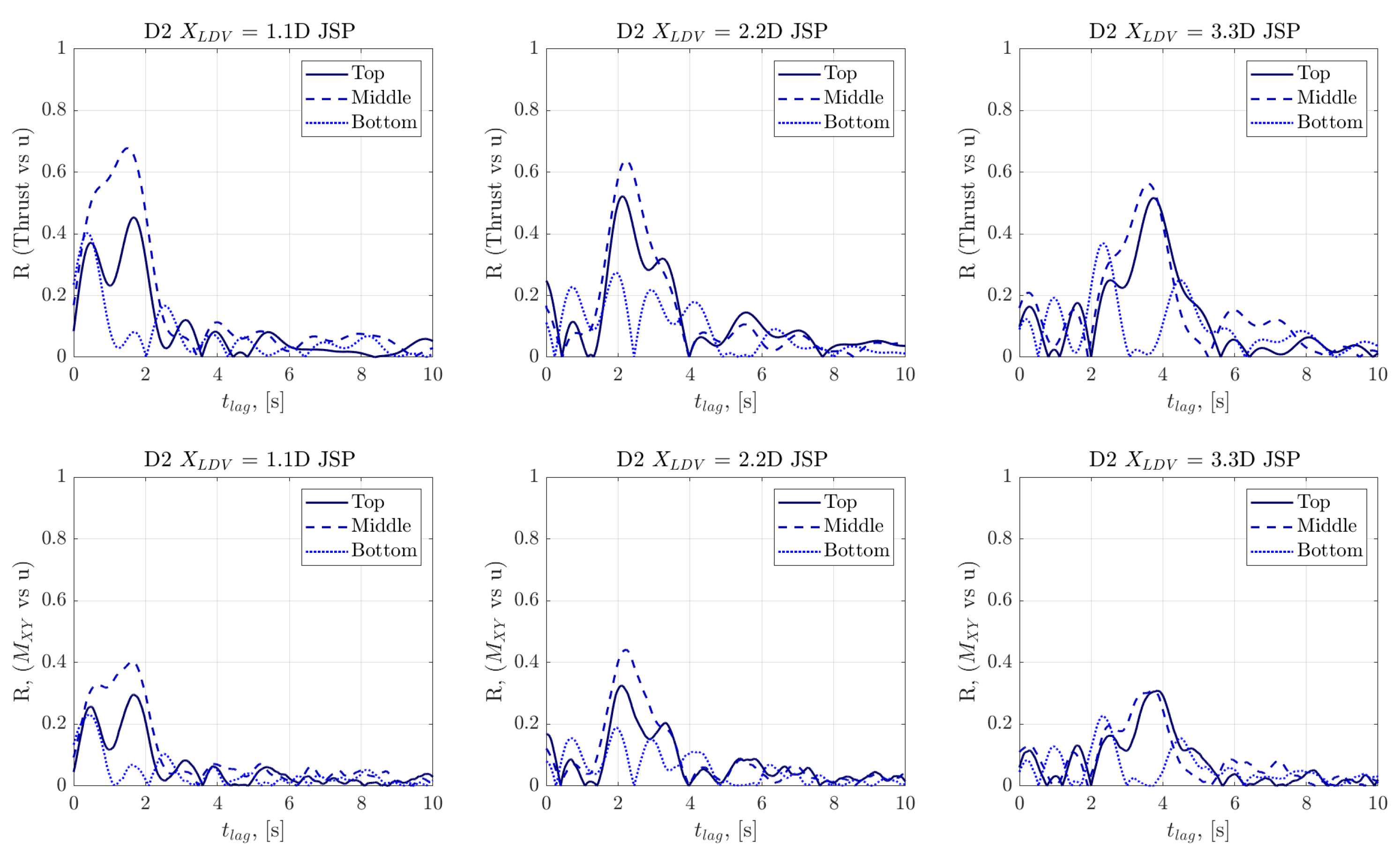
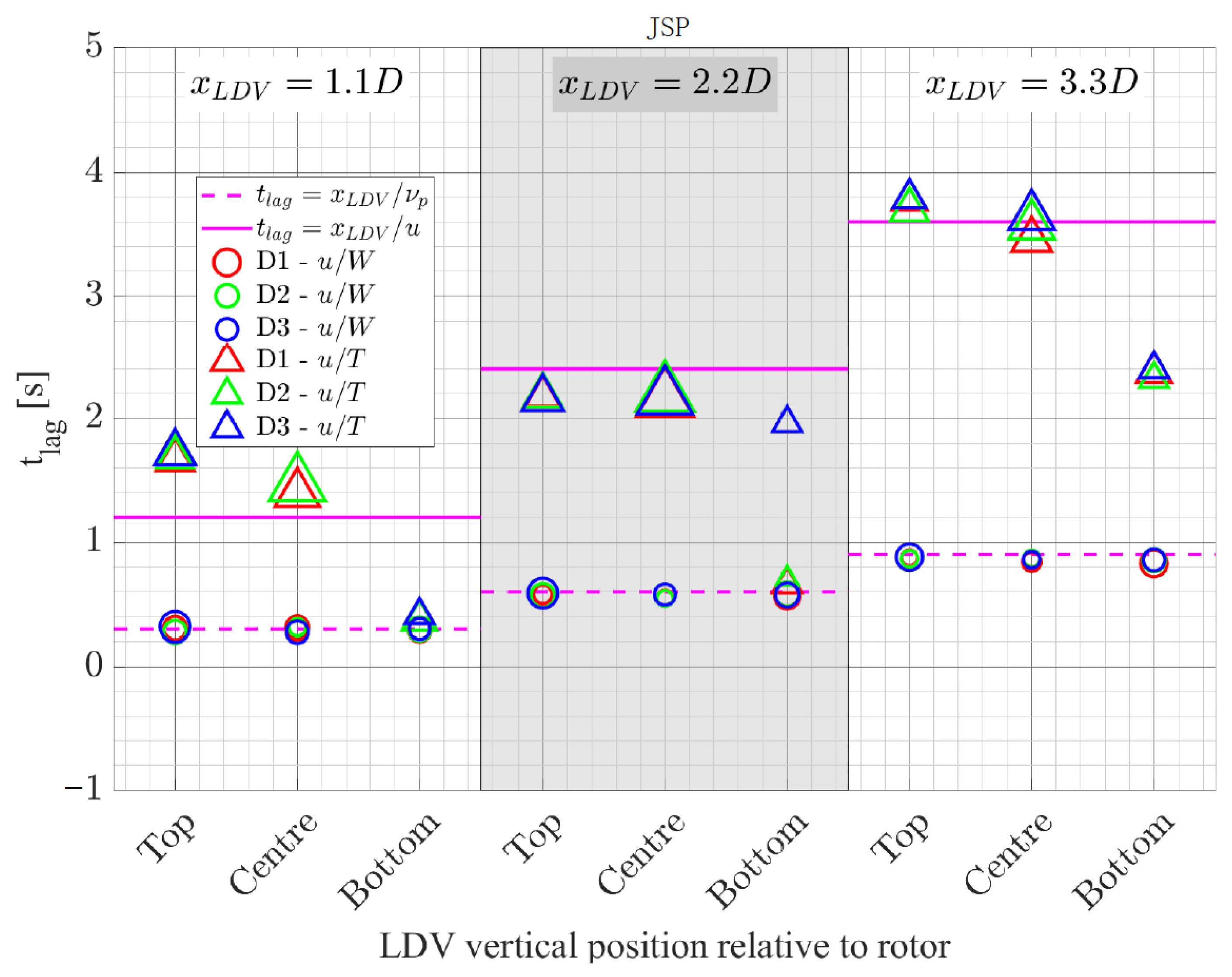

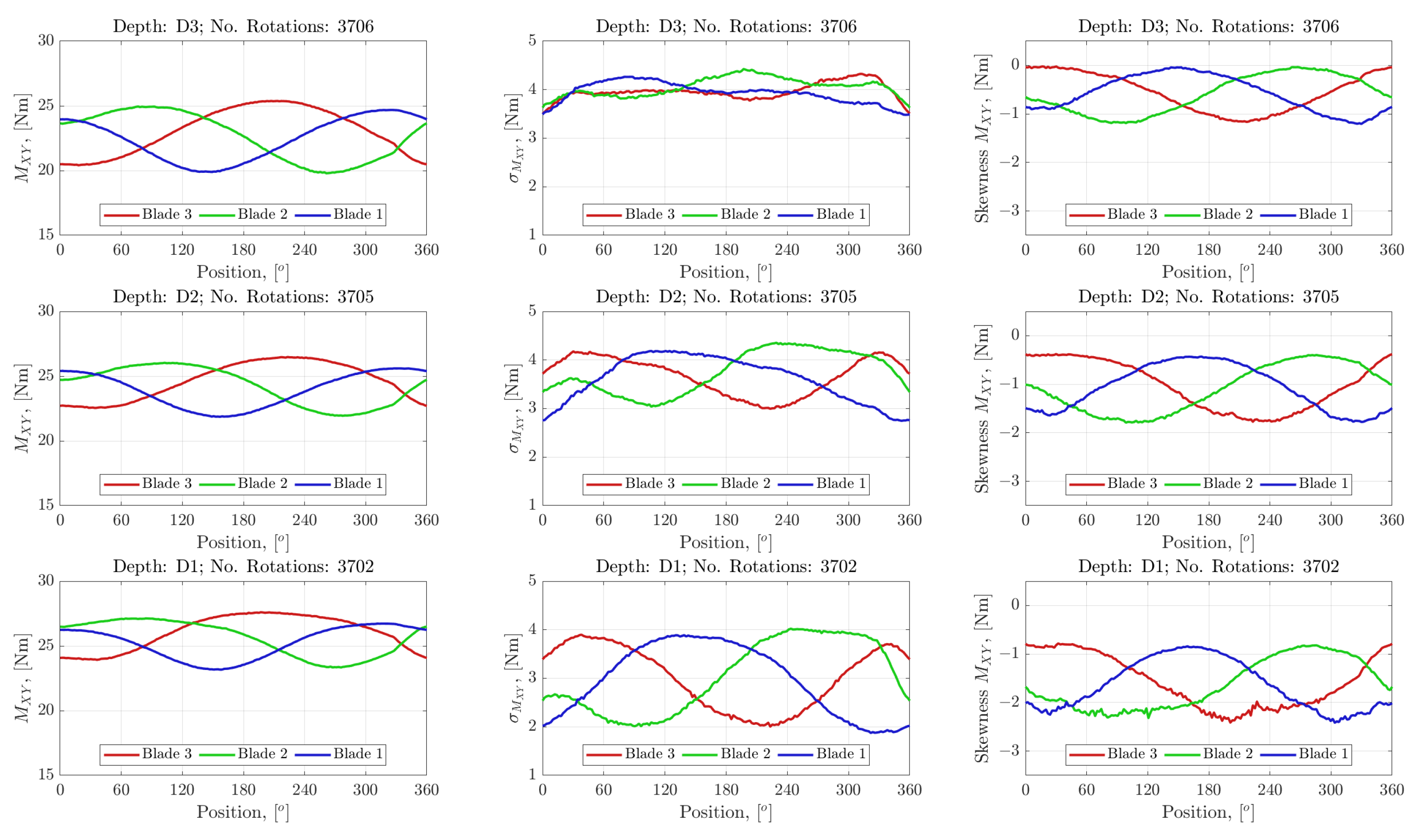
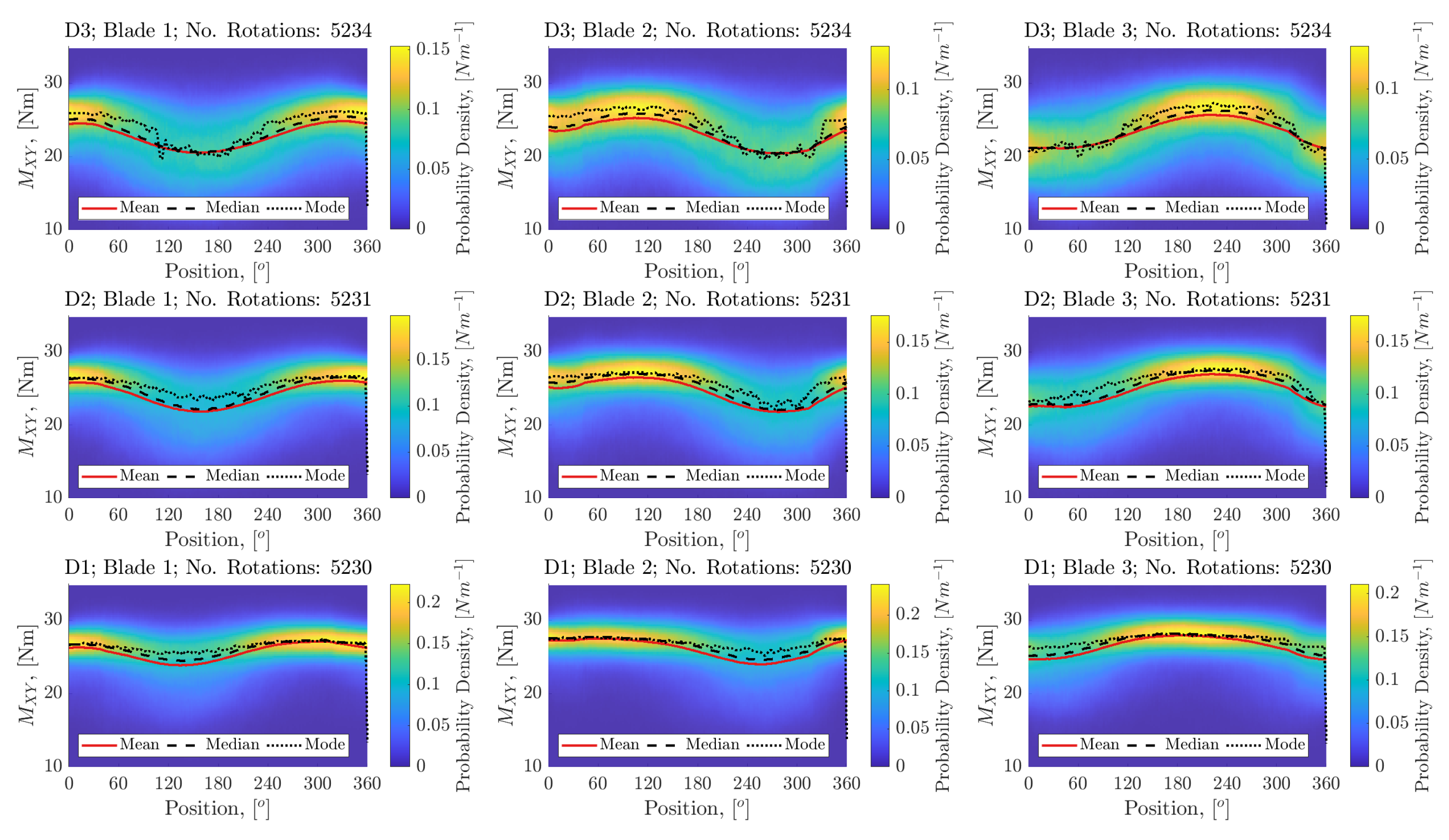
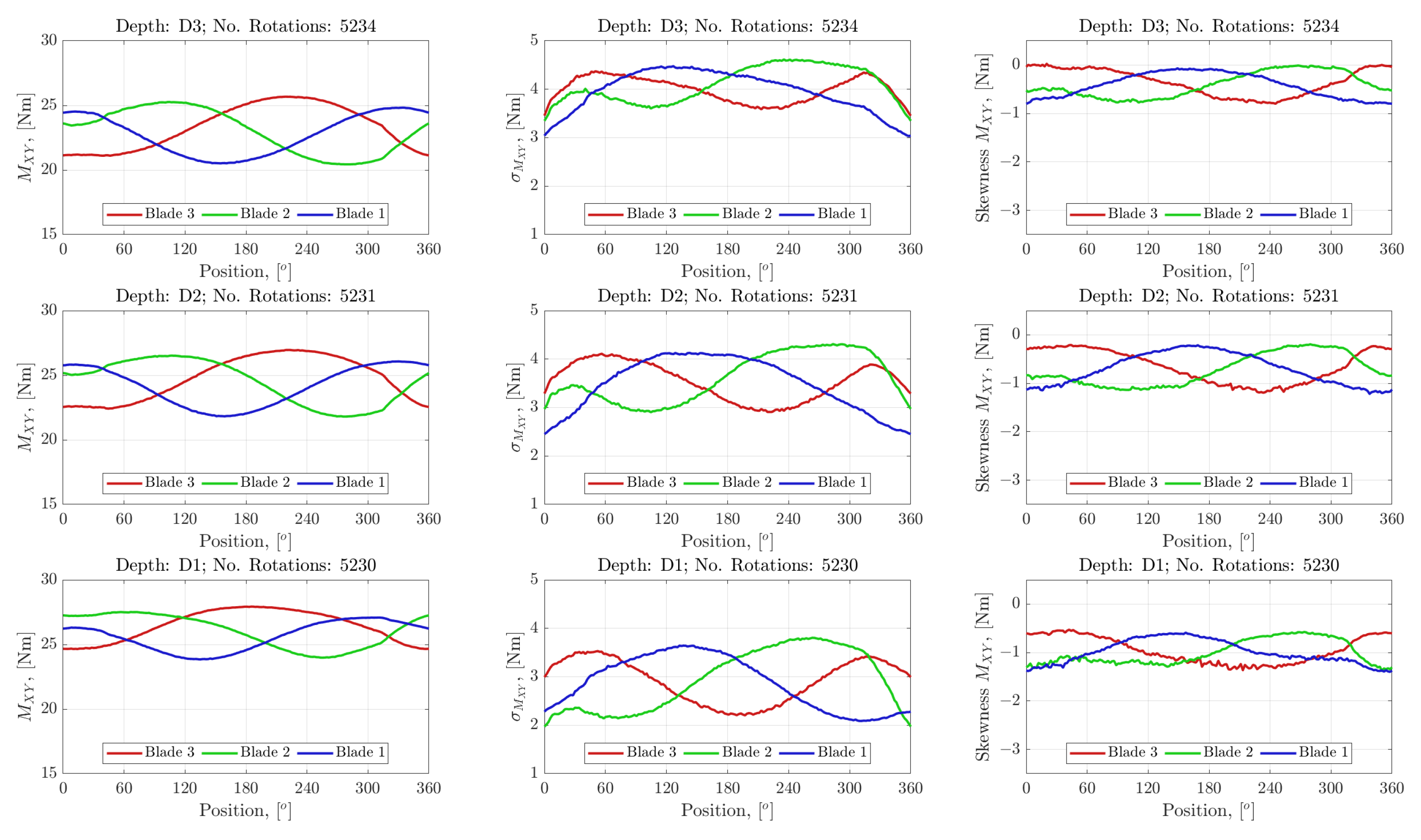
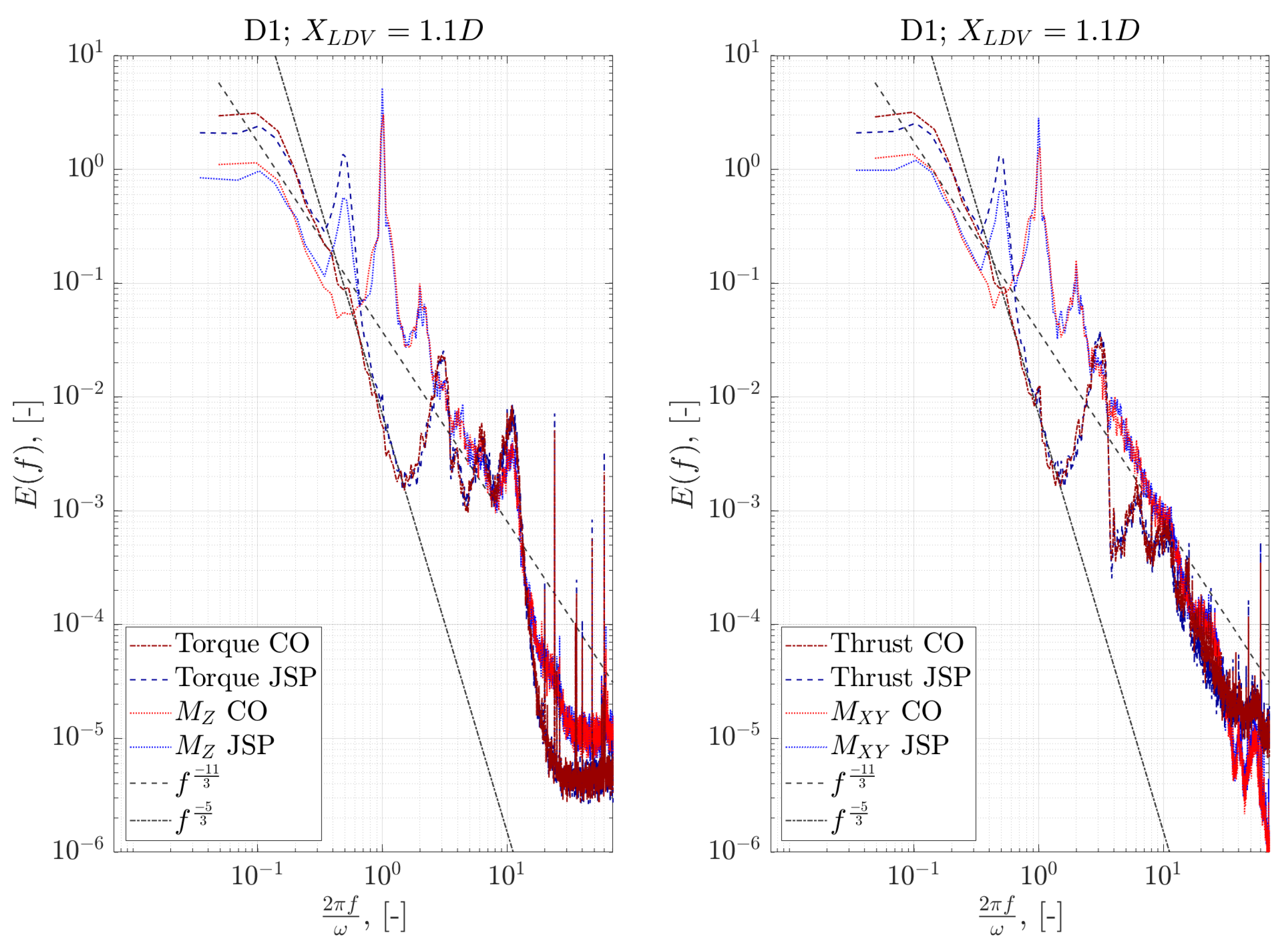
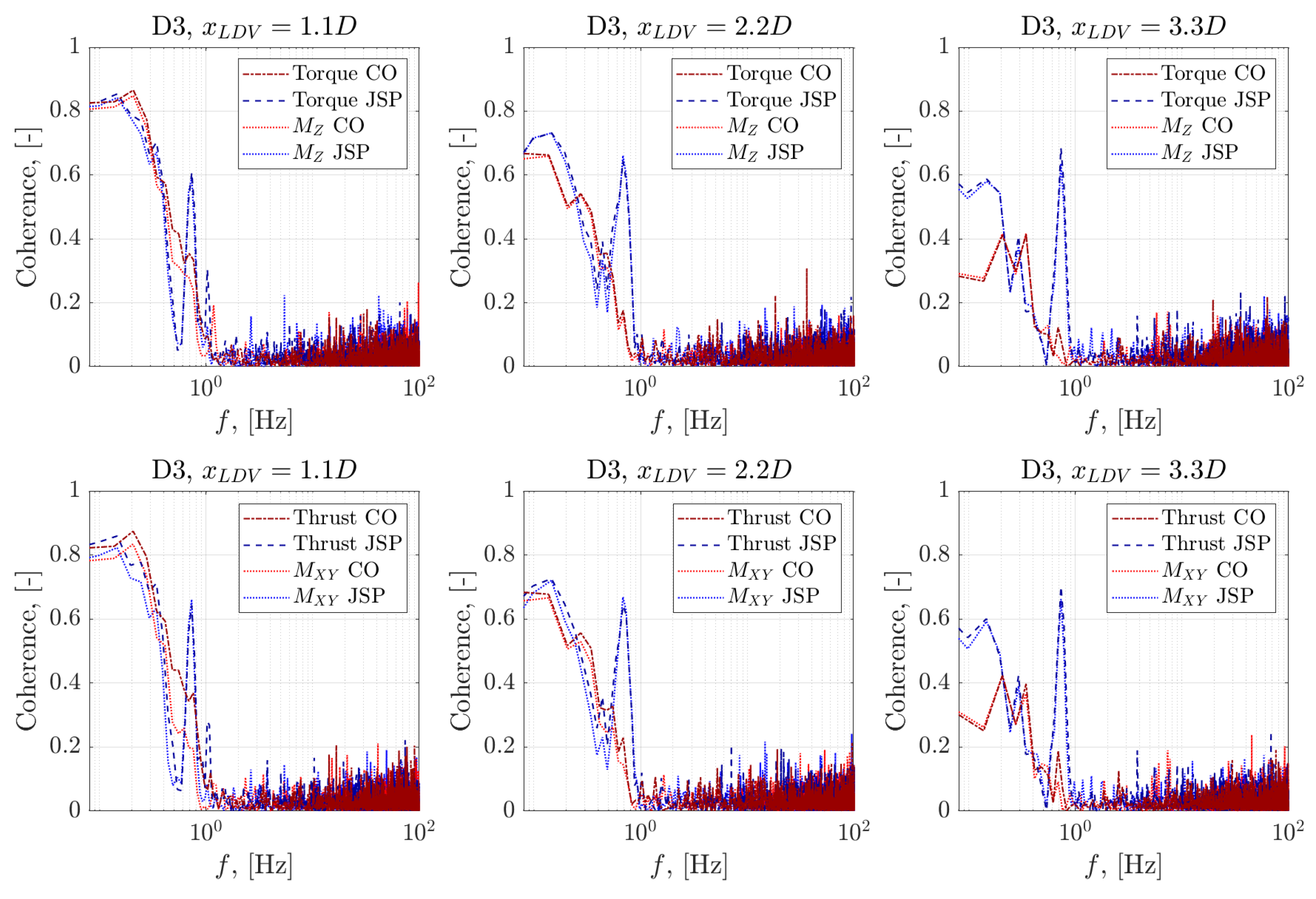
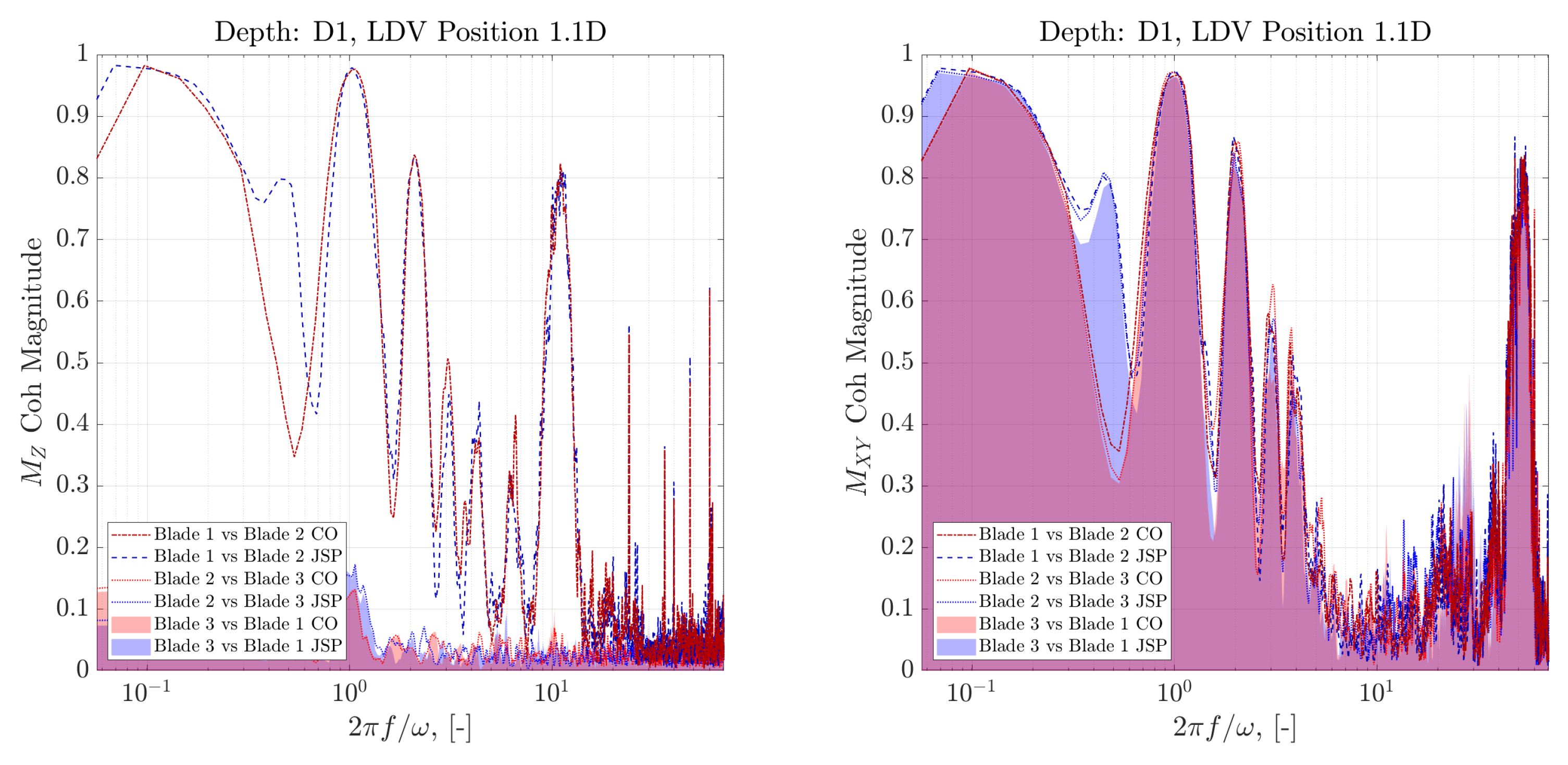
| Case | Wave Type | Water | Flow | Wave | Wave | Wave |
|---|---|---|---|---|---|---|
| Depth | Speed | Height | Frequency | Length | ||
| h [m] | [m/s] | [m] | [Hz] | L [m] | ||
| CO | Current Only | 2 | 1.0 | - | - | - |
| JSP | JONSWAP | 2 | 1.0 | 0.15 | 0.70 | 3.19 |
| JSP 1,* | JONSWAP | 25 | 3.53 | 1.88 | 0.20 | 39.83 |
| JSP 1,** | JONSWAP | 40 | 4.47 | 3.00 | 0.16 | 63.73 |
Publisher’s Note: MDPI stays neutral with regard to jurisdictional claims in published maps and institutional affiliations. |
© 2021 by the authors. Licensee MDPI, Basel, Switzerland. This article is an open access article distributed under the terms and conditions of the Creative Commons Attribution (CC BY) license (https://creativecommons.org/licenses/by/4.0/).
Share and Cite
Allmark, M.; Martinez, R.; Ordonez-Sanchez, S.; Lloyd, C.; O’Doherty, T.; Germain, G.; Gaurier, B.; Johnstone, C. A Phenomenological Study of Lab-Scale Tidal Turbine Loading under Combined Irregular Wave and Shear Flow Conditions. J. Mar. Sci. Eng. 2021, 9, 593. https://doi.org/10.3390/jmse9060593
Allmark M, Martinez R, Ordonez-Sanchez S, Lloyd C, O’Doherty T, Germain G, Gaurier B, Johnstone C. A Phenomenological Study of Lab-Scale Tidal Turbine Loading under Combined Irregular Wave and Shear Flow Conditions. Journal of Marine Science and Engineering. 2021; 9(6):593. https://doi.org/10.3390/jmse9060593
Chicago/Turabian StyleAllmark, Matthew, Rodrigo Martinez, Stephanie Ordonez-Sanchez, Catherine Lloyd, Tim O’Doherty, Grégory Germain, Benoît Gaurier, and Cameron Johnstone. 2021. "A Phenomenological Study of Lab-Scale Tidal Turbine Loading under Combined Irregular Wave and Shear Flow Conditions" Journal of Marine Science and Engineering 9, no. 6: 593. https://doi.org/10.3390/jmse9060593
APA StyleAllmark, M., Martinez, R., Ordonez-Sanchez, S., Lloyd, C., O’Doherty, T., Germain, G., Gaurier, B., & Johnstone, C. (2021). A Phenomenological Study of Lab-Scale Tidal Turbine Loading under Combined Irregular Wave and Shear Flow Conditions. Journal of Marine Science and Engineering, 9(6), 593. https://doi.org/10.3390/jmse9060593










